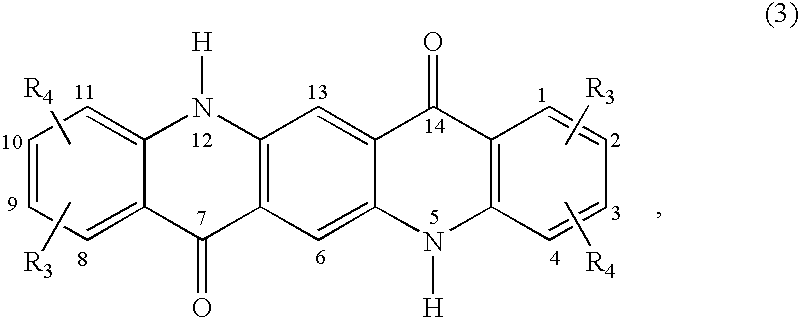Quinacridone pigment compositions comprising unsymmetrically substituted components
a technology of unsymmetrical substitution and pigment composition, which is applied in the direction of instruments, organic chemistry, inks, etc., can solve the problems of solid solutions giving unexpected and unpredictable hues
- Summary
- Abstract
- Description
- Claims
- Application Information
AI Technical Summary
Benefits of technology
Problems solved by technology
Method used
Image
Examples
example 1
[0136]A pressure reactor autoclave is charged with 30 parts of well dried dimethylsuccinylo succinate (1,4-cyclohexanedione-2,5-di-carboxylic acid methyl ester), 5.6 parts of aniline, 23.6 parts of para-toluidine, 300 parts of methanol and 0.9 parts of hydrochloric acid (35%). The autoclave is tightly closed and flushed with nitrogen gas and the pressure is set at a gauge pressure of 0 kg / cm2. While the mixture is vigorously stirred, the temperature in the autoclave is increased from room temperature to 90° C. over 15 minutes and the mixture is allowed to react for 5 hours. Then, the reaction mixture is cooled to 30° C. or lower and the pressure is released to atmospheric pressure. The autoclave is charged with 40 parts of a sodium hydroxide solution (50%) and 34.6 parts of sodium m-nitrobenzenesulfonate and tightly closed. The mixture is stirred for 10 minutes and the temperature in the autoclave is increased from room temperature to 90° C. over 15 minutes. Then the mixture is allo...
example 2
[0138]A flask equipped with a condenser and a nitrogen inlet tube is charged with 30 parts of well dried dimethylsuccinylo succinate (1,4-cyclohexanedione-2,5-di-carboxylic acid methyl ester), 5.6 parts of aniline, 23.6 parts of para-toluidine, 300 parts of ethanol and 0.9 parts of hydrochloric acid (35%) and flushed with nitrogen gas. While the mixture is vigorously stirred, the temperature is increased from room temperature to 78° C. over 15 minutes and the mixture is allowed to react for 4 hours. The reaction mixture is cooled to 30° C. or less and the flask is charged with 72 parts of an aqueous potassium hydroxide solution (50%) and 34.6 parts of sodium m-nitrobenzenesulfonate. The temperature is increased to 78° C. over 15 minutes while stirring and the mixture is allowed to react for 5 hours. The reaction mixture is cooled to 30° C. or lower and filtered to remove any solids. The remaining solution is heated to a temperature of 30–40° C. with stirring. 23 parts of hydrochlori...
example 2a
[0139]A flask equipped with a condenser and a nitrogen inlet tube is charged with 30 parts of well dried dimethylsuccinylo succinate (1,4-cyclohexanedione-2,5-di-carboxylic acid methyl ester), 7.08 parts of aniline, 300 parts of ethanol and 0.9 parts of hydrochloric acid (35%) and flushed with nitrogen gas. While the mixture is vigorously stirred, the temperature is increased from room temperature to 78° C. over 15 minutes and the mixture is allowed to react for 2.5 hr. The reaction mixture is cooled to 40–45° C., 23.6 parts of para-toluidine were added and the mixture was refluxed 2.5 hr more. The reaction mixture is cooled to 30° C. or less and the flask is charged with 72 parts of an aqueous potassium hydroxide solution (50%) and 34.6 parts of sodium m-nitrobenzenesulfonate. The temperature is increased to 78° C. over 15 minutes while stirring and the mixture is allowed to react for 5 hours. The reaction mixture is cooled to 30° C. or lower and filtered to remove any solids. The ...
PUM
| Property | Measurement | Unit |
|---|---|---|
| temperature | aaaaa | aaaaa |
| temperature | aaaaa | aaaaa |
| ring closure temperature | aaaaa | aaaaa |
Abstract
Description
Claims
Application Information
 Login to View More
Login to View More - R&D
- Intellectual Property
- Life Sciences
- Materials
- Tech Scout
- Unparalleled Data Quality
- Higher Quality Content
- 60% Fewer Hallucinations
Browse by: Latest US Patents, China's latest patents, Technical Efficacy Thesaurus, Application Domain, Technology Topic, Popular Technical Reports.
© 2025 PatSnap. All rights reserved.Legal|Privacy policy|Modern Slavery Act Transparency Statement|Sitemap|About US| Contact US: help@patsnap.com



